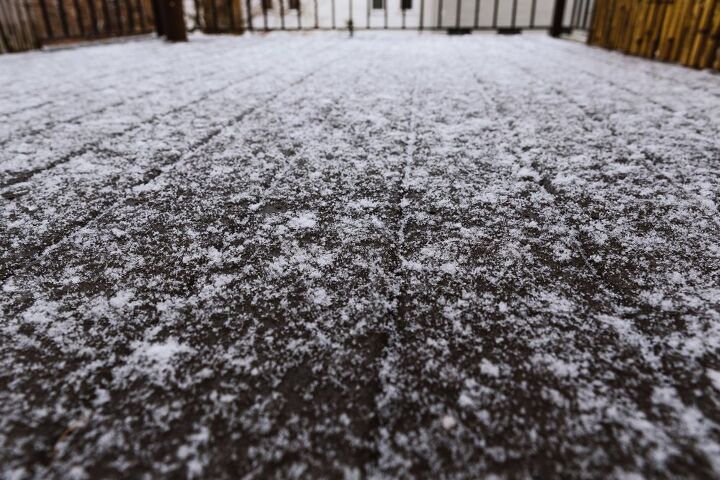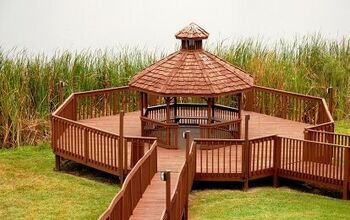Can You Put Ice Melt On Trex Decking? (Find Out Now!)

Your new Trex composite deck is finished and has been a joy all summer long. With winter approaching, you begin to wonder about maintaining your deck. With ice and snow on the way, your Trx decking can become a hazardous place. A legitimate question is whether ice melt products are safe for your Trex decking.
The chemical composition of the ice melt product is the key factor. You certainly don’t want to put anything on your Trex deck that would harm your children or your pets. You should avoid ice melts that contain corrosive products that can harm the metal fittings of your deck. In general, ice melt products won’t harm the Trex material itself.
You can use ice melt on your Trex deck if you are careful. There are some tricks and tips for choosing the right ice melt product for your composite wood deck. Following these tips and tricks will get your Trex deck through the winter in great shape.
Do You Need Snow Removal Services?
Get free, zero-commitment quotes from pro contractors near you.

What is Trex Decking?
The official definition of Trex decking material is rather overwhelming. Technically, Trex is a brand name of a composite wood product manufactured by the American company Trex. There are other manufacturers of composite wood decking products, but the term Trex has become synonymous with all of these products.
Trex and other brands of composite decking are not plastic, and they aren’t wood. Instead, wood chips and wood dust are mixed with a polymer resin and shaped into the decking materials. The wood grain designs are a plastic film that is wrapped around the wood and polymer core.
Composite decking like Trex is dimensionally stable. These products won’t warp, bend, twist or bow. The polymer used to bind the wood products together is highly water-resistant, and the vinyl skins that give the composite materials a look and feel of wood grain are tough and durable.
Ice Melt – Not Just Salt
Most people are familiar with ice melt products. What many don’t understand is the differences in the chemical used in these products. Each chemical can affect wood, concrete, and composite deck surfaces differently.
Technically all ice melt products are a salt. This means another chemical has been combined chemically with a chlorine atom to create a new substance. Good old table salt, sodium chloride, has been used as an ice melt product for many years. Now many other chloride products are commonly used as ice melt. Each has its advantages and disadvantages. Some are safer than others to use on your Trex decking.
Sodium Chloride
Sodium chloride in the form of rock salt has been used for hundreds of years to melt ice. However, rock salt does have its downsides and, for the most part, should be avoided around your home.
- Rock salt isn’t as efficient as other ice melt materials. The sodium chloride will only melt ice down to 20 degrees Fahrenheit. Below 20 degrees, the water will begin to refreeze despite the rock salt.
- The runoff meltwater containing the dissolved sodium chloride is toxic to plants and animals. Your landscape around your home and lawn can easily be damaged by the rock salt runoff from your deck or sidewalks.
- Sodium chloride, when combined with water, can be highly corrosive. This runoff can damage the metal connectors and other parts of your deck. On real wood decks, the salt can be absorbed into the wood and hasten the deterioration of your deck.
Because rock salt is relatively cheap, it is favored when very large applications must be made to control ice. Rock salt is commonly used on streets and car parks.
Calcium Magnesium Chloride
Some ice melt products use calcium-magnesium chloride. This product is considered less hazardous to the environment. Calcium magnesium chloride is considered to be bio-degradable and much safer than rock salt.
Calcium-magnesium chloride is less corrosive than sodium chloride, making it safer for the metal parts of your wood composite deck. You can safely use calcium-magnesium ice melt without fear for your landscaping or your pets.
Calcium Chloride
In climates where the temperature routinely falls below 20 degrees Fahrenheit, calcium chloride is the only real choice for ice melt on your Trex deck. There are several reasons that calcium chloride ice melt is the best choice for Trex decking material.
- Calcium chloride ice melt products continue to work down to -25 degrees Farhenheit. This helps keep your Trex deck clear in even the worst winter conditions.
- The runoff from calcium chloride is non-toxic to plants and animals and can be used with confidence around your landscaping and your pets.
- You won’t need to worry about corrosion. Calcium chloride has the least effect on the metal parts of your Trex deck of either rock salt or calcium-magnesium ice melt products.
Calcium chloride-based ice melt products are the best choice for your Trex wood composite decking for fast ice removal and protection to extremely low temperatures.
Other Things to Watch Out For Using Ice Melt on your Trex Deck
The chemical used in the ice melt product you chose is not the only thing to consider. Most ice melt manufacturers include small amounts of other products to enhance the ice melt and safety. You should avoid putting ice melt products with these added ingredients onto your Trex deck.
Avoid Ice Melt Products with Traction Grit Materials Added
Some ice melt products contain small amounts of grit meant to increase traction on the ice as it melts. These products may include:
- Sand
- Sawdust
- Clay (in the form of kitty litter)
- Birdseed
- Chicken Grit (another clay product)
- Oyster shells
While these materials, in and of themselves, won’t harm your Trex decking, the rough texture of these products can harm the surface of your Trex deck. As you walk on these hard and gritty substances, they act like sandpaper on your deck surface. This sandpaper action can eventually leave scratches that affect the visual appeal of your deck.
Beware of Colorants Used in Ice Melt Products on your Trex Deck
Many ice melt manufacturers include small amounts of colorants in their products. The concept is to make the ice melt product easier to see on snow and ice. This is supposed to make getting proper coverage with the ice melt material easier, reducing cost and avoiding wastage.
The downside is that the colorant may stain or change the color of your Trex decking in some cases. This often appears as dark or lighter colored blotchy stains on your decking that you can’t remove with normal cleaners.
Do You Need Snow Removal Services?
Get free, zero-commitment quotes from pro contractors near you.

Protecting You, Your Family, and your Trex Deck From Ice
In the end, protecting you, your family and friends, and your Trex deck from ice is a priority. Choosing a quality calcium chloride ice melt product is your best option. Avoid those ice melt products with any kind of traction material or colorants that could harm your deck. A good ice melt product will leave you ice-free and with a great-looking deck in the spring.

Dennis is a retired firefighter with an extensive background in construction, home improvement, and remodeling. He worked in the trades part-time while serving as an active firefighter. On his retirement, he started a remodeling and home repair business, which he ran for several years.
More by Dennis Howard



























